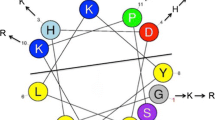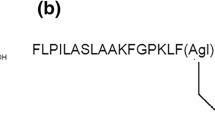Abstract
Understanding the molecular mechanisms of antimicrobial peptide–membrane interactions is crucial in predicting the design of useful synthetic antimicrobial peptide analogues. Defensins are small (3–5 kDa) cysteine-rich cationic proteins which constitute the front line of host innate immunity. In this study, a series of eight 10 AA C-terminal analogues of hBD3 [sequence: RGRKXXRRKK, X = W, F, Y, V, L, I, H, C(Acm); net charge = +7, coded as W2, F2, Y2, V2, L2, I2, H2, and C2] and covalent V2-dimer [(RGRKVVRR)2KK] (18 AA, net charge = +11) were synthesized using solid phase peptide synthesis (SPPS) in Fmoc chemistry. Wild-type hBD3 was used as a control in all analyses. W2, V2, and especially Y2 showed high activity selectively against Gram-negative bacteria Pseudomonas aeruginosa in the concentration range of 4.3–9.7 μM. The covalent dimeric form of V2-monomer, V2-dimer, showed increased antibacterial killing compared to the monomeric form, V2-monomer. Cytotoxicity assays on a human conjunctival epithelial cell line (IOBA-NHC cells) showed that no change in viable cell number 24 h after constant exposure to all the eight peptide analogues even at concentrations up to 200 μg/ml. Fluorescence correlation spectroscopy (FCS) was used to study the interaction of these peptides against POPC vesicles (neutral; mammalian cell membrane mimic) and POPG vesicles (negatively charged; bacterial cell membrane mimic). Using FCS, significant aggregation and some leakage of Rhodamine dye were observed with POPG with Y2, W2 and V2 at the concentration of 5–10 μM and no significant aggregation or disruption of vesicles was observed for all peptide analogues tested against POPC. V2-dimer induced more leakage and aggregation than the monomeric form. Overall, V2-dimer is the most effective antimicrobial peptide, with aggregation of POPG vesicles observed at concentrations as low as 1 μM. The concentration of 5–10 μM for Y2 from FCS correlated with the concentration of 5 μM (6.25 μg/ml), at which Y2 showed a cooperative increase in the activity. This suggests a structural transition of Y2 in the 2.5–5 μM concentration range resulting in the correlated increased antimicrobial activity. These results and the FCS together with previous NMR and molecular dynamics (MD) suggested that the charge density-based binding affinity, stable covalent dimerization, the ability to dimerize or even oligomerize and adopt a well-defined structure are important physicochemical properties distinguishing more effective cationic antimicrobial peptides.




Similar content being viewed by others
References
Bai Y, Liu SP, Jiang P, Zhou L, Li J, Tang C, Verma C, Mu YG, Beuerman RW, Pervushin K (2009) Structure-dependent charge density as a determinant of antimicrobial activity of peptide analogues of defensin. Biochemistry 48:7229–7239
Bauer F, Schweimer K, Kluver E, Conejo-Garcia JR, Forssmann WG, Rosch P, Adermann K, Sticht H (2001) Structure determination of human and murine beta-defensins reveals structural conservation in the absence of significant sequence similarity. Protein Sci 10:2470–2479
Bevins CL, Martin-Porter E, Ganz T (1999) Defensins and innate host defence of the gastrointestinal tract. Gut 45:911–915
Boman HG (1995) Peptide antibiotics and their role in innate immunity. Annu Rev Immunol 13:61–92
Cullor JS, Mannis MJ, Murphy CJ, Smith WL, Selsted ME, Reid TW (1990) In vitro antimicrobial activity of defensins against ocular pathogens. Arch Ophthalmol 108:861–864
Dhople V, Krukemeyer A, Ramamoorthy A (2006) The human beta-defensin-3, an antibacterial peptide with multiple biological functions. Biochim Biophys Acta 1758:1499–1512
Diamond G, Bevins CL (1998) beta-Defensins: endogenous antibiotics of the innate host defense response. Clin Immunol Immunopathol 88:221–225
Diebold Y, Calonge M, Enriquez de Salamanca A, Callejo S, Corrales RM, Saez V, Siemasko KF, Stern ME (2003) Characterization of a spontaneously immortalized cell line (IOBA-NHC) from normal human conjunctiva. Invest Ophthalmol Vis Sci 44:4263–4274
Dunsche A, Açil Y, Dommisch H, Siebert R, Schröder JM, Jepsen S (2002) The novel human beta-defensin-3 is widely expressed in oral tissues. Eur J Oral Sci 110:121–124
Ganz T, Lehrer RI (1995) Defensins. Pharmacol Ther 66:191–205
Hancock RE, Falla T, Brown M (1995) Cationic bactericidal peptides. Adv Microb Physiol 37:135–175
Hopp TP, Woods KR (1981) Prediction of protein antigenic determinants from amino acid sequences. Proc Natl Acad Sci USA 78:3824–3828
Hwang PM, Vogel HJ (1998) Structure–function relationships of antimicrobial peptides. Biochem Cell Biol 76:235–246
Kluver E, Schulz-Maronde S, Scheid S, Meyer B, Forssmann WG, Adermann K (2005) Structure-activity relation of human beta-defensin 3: influence of disulfide bonds and cysteine substitution on antimicrobial activity and cytotoxicity. Biochemistry 44:9804–9816
Kluver E, Adermann K, Schulz A (2006) Synthesis and structure-activity relationship of beta-defensins, multi-functional peptides of the immune system. J Pept Sci 12:243–257
Krouglova T, Vercammen J, Engelborghs Y (2004) Correct diffusion coefficients of proteins in fluorescence correlation spectroscopy. Application to tubulin oligomers induced by Mg2+ and paclitaxel. Biophys J 87(4):2635–2646
Li J, Raghunath M, Tan D, Lareu RR, Chen Z, Beuerman RW (2006) Defensins HNP1 and HBD2 stimulation of wound-associated responses in human conjunctival fibroblasts. Invest Ophthalmol Vis Sci 47:3811–3819
Liu SP, Zhou L, Li J, Suresh A, Verma C, Foo YH, Yap EP, Tan DT, Beuerman RW (2008) Linear analogues of human beta-defensin 3: concepts for design of antimicrobial peptides with reduced cytotoxicity to mammalian cells. ChemBioChem 9:964–973
Magde D, Webb WW, Elson EL (1972) Thermodynamic fluctuations in a reacting system: measurement by fluorescence correlation spectroscopy. Phys Rev Lett 29:705–708
McDermott AM, Redfern RL, Zhang B, Pei Y, Huang L, Proske RJ (2003) Defensin expression by the cornea: multiple signalling pathways mediate IL-1beta stimulation of hBD-2 expression by human corneal epithelial cells. Invest Ophthalmol Vis Sci 44:1859–1865
Parks QM, Hobden JA (2005) Polyphosphate kinase 1 and the ocular virulence of Pseudomonas aeruginosa. Invest Ophthalmol Vis Sci 46:248–251
Persson D, Thorén PE, Nordén B (2001) Penetratin-induced aggregation and subsequent dissociation of negatively charged phospholipid vesicles. FEBS Lett 505:307–312
Pramanik A, Thyberg P, Rigler R (2000) Molecular interactions of peptides with phospholipid vesicle membranes as studied by fluorescence correlation spectroscopy. Chem Phys Lipids 104:35–47
Raguse TL, Porter EA, Weisblum B, Gellman SH (2002) Structure–activity studies of 14-helical antimicrobial beta-peptides: probing the relationship between conformational stability and antimicrobial potency. J Am Chem Soc 124:12774–12785
Raj PA, Dentino AR (2002) Current status of defensins and their role in innate and adaptive immunity. FEMS Microbiol Lett 206:9–18
Schmitt MA, Weisblum B, Gellman SH (2007) Interplay among folding, sequence, and lipophilicity in the antibacterial and hemolytic activities of alpha/beta-peptides. J Am Chem Soc 129:417–428
Yeaman MR, Yount NY (2003) Mechanisms of antimicrobial peptide action and resistance. Pharmacol Rev 55:27–55
Yu LL, Ding JL, Ho B, Wohland T (2005) Investigation of a novel artificial antimicrobial peptide by fluorescence correlation spectroscopy: An amphiphilic cationic pattern is sufficient for selective binding to bacteria type membranes and antimicrobial activity. Biochem Biophys Acta 1716:29–39
Yu L, Tan M, Ho B, Ding JL, Wohland T (2006) Determination of critical micelle concentrations and aggregation numbers by fluorescence correlation spectroscopy: aggregation of a lipopolysaccharide. Anal Chim Acta 556:216–225
Yu L, Ding JL, Ho B, Feng SS, Wohland T (2008) Investigation of the mechanisms of antimicrobial peptides interacting with membranes by fluorescence correlation spectroscopy. Open Chem Phys J 1:62–80
Zhou L, Huang LQ, Beuerman RW, Grigg ME, Li SF, Chew FT, Ang L, Stern ME, Tan D (2004) Proteomic analysis of human tears: defensin expression after ocular surface surgery. J Proteome Res 3:410–416
Acknowledgments
This work was supported by the National Medical Research Council of Singapore (NMRC) grants: 1106/2007, 0808/2003, BMRC/R652/73/2008. OLB, LG, and TW were supported by a faculty research council grant from the National University of Singapore (R-143-000-338-112).
Author information
Authors and Affiliations
Corresponding author
Additional information
L. Zhou and S.P. Liu contributed equally to the work.
Rights and permissions
About this article
Cite this article
Zhou, L., Liu, S.P., Chen, L.Y. et al. The structural parameters for antimicrobial activity, human epithelial cell cytotoxicity and killing mechanism of synthetic monomer and dimer analogues derived from hBD3 C-terminal region. Amino Acids 40, 123–133 (2011). https://doi.org/10.1007/s00726-010-0565-8
Received:
Accepted:
Published:
Issue Date:
DOI: https://doi.org/10.1007/s00726-010-0565-8




